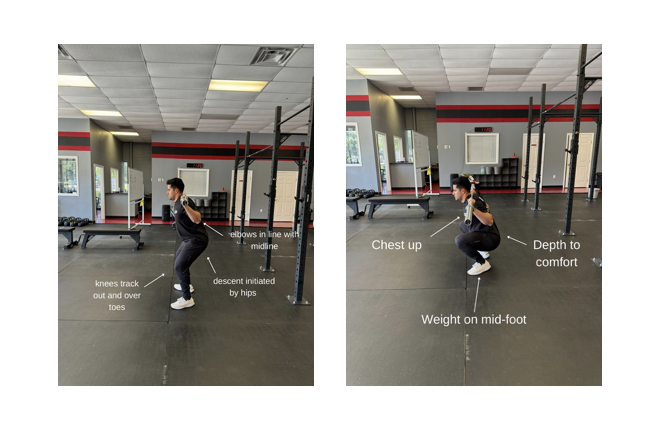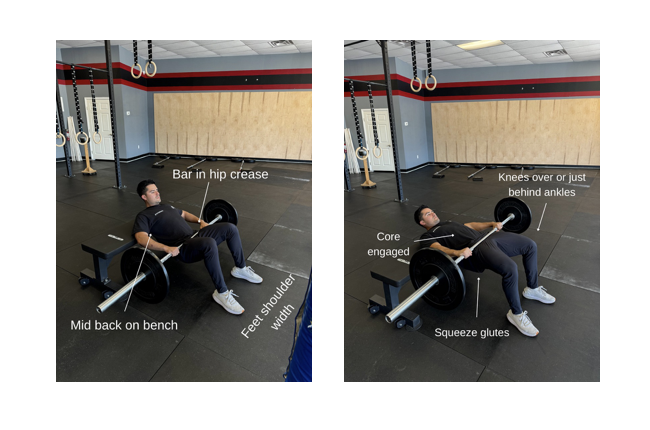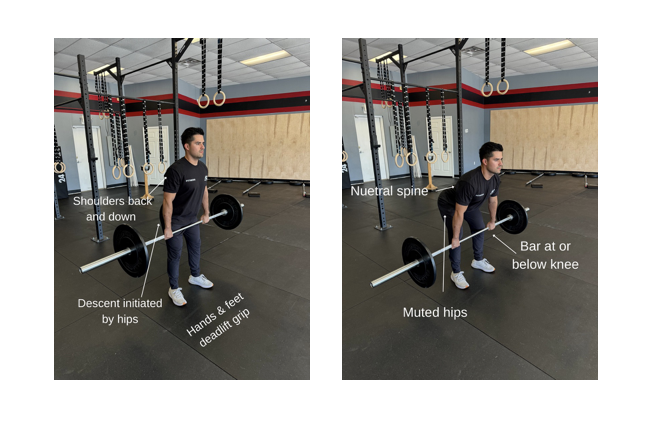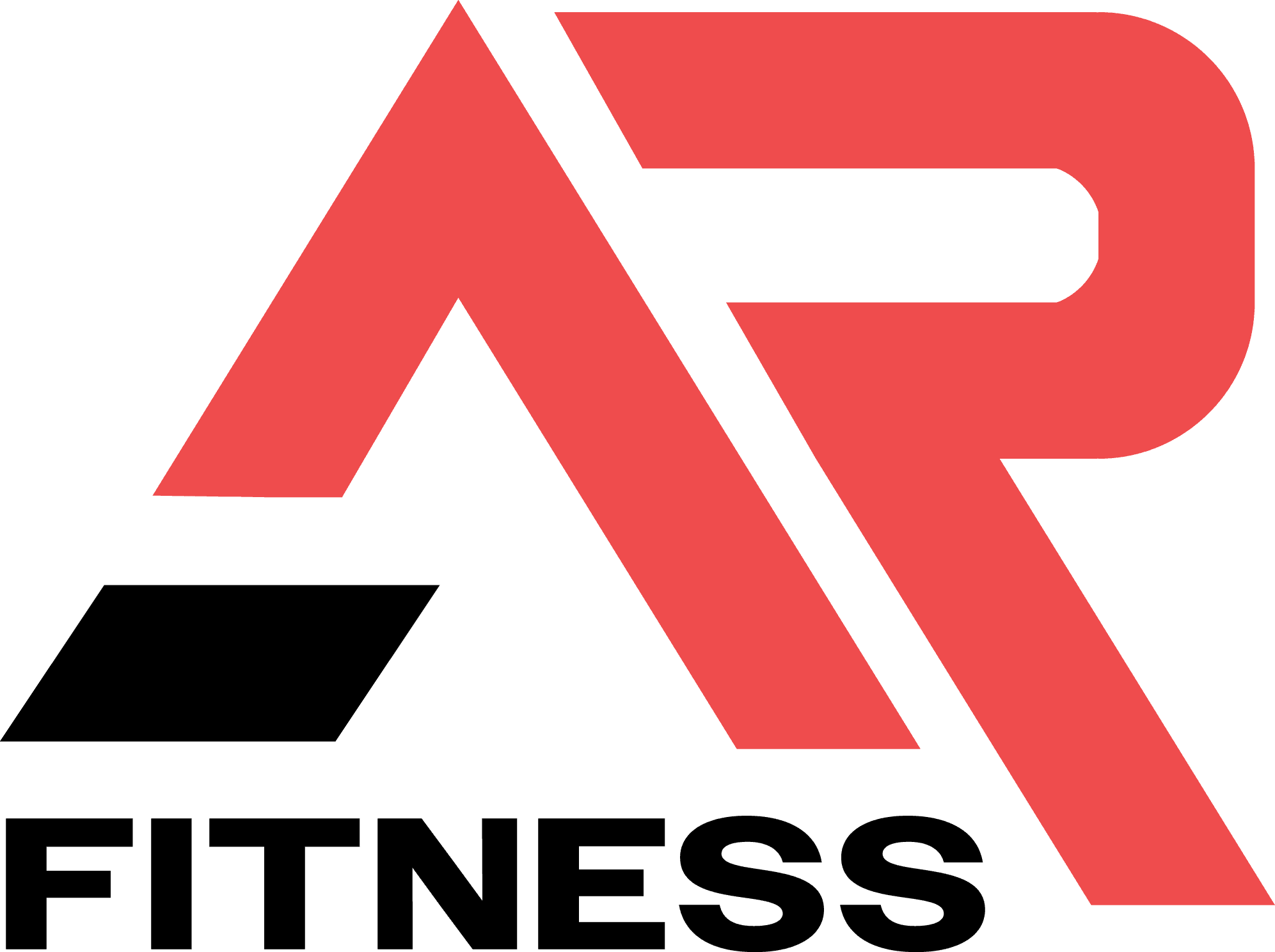Cycle 2 Priority Lifts
Back squat

Proper Mechanics
- Descent initiated by hips: After a proper starting position, your first action when performing a squat is to sit the hips back, before bending at the knees.
- Knees over toes: When the knees begin to bend, ensure that they stay tracking over the toes.
- Elbows in line with the midline: The elbows should stay tucked next to your side, not flaring forward or back.
- Chest up: As you descend and sit in the bottom of the squat, fight to keep your chest as tall as possible.
- Weight on mid-foot: As you descend and at the bottom of your squat, keep your balance over the middle of your foot. Some will find a tendency to shift the weight to the balls of their feet to keep their chest upright. Keeping the weight on your mid-foot ensures the load stays on the hips and knees, not just the knees.
- Depth to comfort: While maintaining other proper mechanics, including a neutral spine, descend as far as possible comfortably. Some will find it difficult to get their hip crease below their knee, but that is the goal almost everyone should be aspiring to achieve.
Common Faults
- Descent initiated by knees: It’s common to see people start their squat by bending at the knees. Doing so increases the load unnecessarily on the joint and musculature of the knees, rather than equally between the knees and hips.
- Valgus knee: Throughout the entirety of the squat, some will struggle with their knees buckling inward. This is called valgus knee. This can put potentially damaging compressive forces on the knee joint in a position that is sub-optimal.
- Elbows flaring back or forward: When the elbows flare forward or back during any portion of the squat, it can decrease the tension of the upper back and potentially lead to injury of the spine.
- Forward chest lean: It’s common for those with sub-optimal mobility of the ankles, knees and/or hips to lean forward during the squat. This can increase the loading of the lower back and create improper balance, which could lead to injury.
- Weight on mid-foot: For those with sub-optimal mobility of the ankles and/or hips, it’s common to shift their weight onto their toes to keep an upright chest. This creates an unnecessary increase of loading on the knees, which can lead to injury.
Intent for this Cycle
- Our squat movement of last cycle was high volume walking lunges preceded by reverse sled drags. The focus then was on muscle growth. Now, we can use that hypertrophy to increase our strength in the squat. We’ll be switching back and forth between sets of 5 reps and 3 reps each week, trying to increase in weight bi-weekly. We’ll use a 3 set ascending structure each workout with the last 2 sets being intentionally heavy.
Hip Thrust

Proper Mechanics
- Mid-back on bench: situate the middle of your back (just below the scapulas) on the edge of the bench.
- Feet shoulder width apart: Feet should be closely comparable to squat width, with toes pointed forward or slightly out.
- Bar in hip crease: Using a dumbbell or barbell, put it in your hip crease with your hips flexed as far as possible. If using a barbell, put your hands along it somewhere comfortable with the back of your arms resting against the bench.
- Knee position: At the top of the rep, your knees should be just behind the ankles. This is mostly dictated by foot position relative to the bench.
- Core engaged: At the top of the rep, you core should be engaged and flexed down.
- Glute squeeze: The glutes should be the primary mover of the hip thrust. To ensure this, focus on squeezing the glutes at the top of the rep with a slight pause at peak contraction.
Common Faults
- Foot distance: If your feet are too close to your hips and the bench, your quads become a primary mover, which is not ideal as we’re trying to isolate the glutes. If your feet are too far, your hamstrings become a primary mover. Again, not ideal.
- Hyperextension: It’s common for people to hyperextend their back at the top of the rep for added range of motion. This can aggravate your back and cause pain, especially for those who are prone to back pain.
- Improper foot drive: Because the glutes are rarely isolated in people’s training programs, “activating” them can be difficult for some during the hip thrust. It’s common for some to push through the balls of their feet during the movements. This can shift the stimulus from the glutes to the quads. Rather, you should drive through the heels, which can help you feel it in the glutes.
Intent for this Cycle
- This cycle we’ll be super-setting high volume hip thrusts with RDLs. The overall goal is muscle growth of the glutes and hamstrings. This should carry potentiate strength gains in other movements like deadlifts, cleans, and snatches, while also increasing the resiliency of your back from pain for other hinge movements.
RDLs

Proper Mechanics
- Starting position: Feet placement should be under the hips or just outside of them. Hand placement should be as narrow as possible while still keeping them outside of the thighs.
- Descent initiated by hips: Similar to the back squat, the movement starts by pushing the hips back while keeping the knees locked in a slightly bent position.
- Shoulder position: The shoulders stay retracted and depressed, or “back and down”, throughout the entire movement. This aids in keeping your spine neutral and the load on the glutes/hamstrings.
- Hips muted: The hips should only move horizontally, not vertically. Vertical movement if the hips shifts the load to the quads, and decreases the intended stimulus.
- Range of motion: The range of motion is going to vary for each individual depending on their hamstring and hip flexibility. You should only go as low as your flexibility allows without rounding your back. For those with high flexibility, descend the barbell to just above the ground, without touching the ground.
Common Faults
- Rounding of the shoulders: It’s common for people’s shoulders to round as the barbell descends. This can put unnecessary load on your spine. Focus on keeping the shoulders back and down.
- Squatting the bar: The RDL is intended to be strictly a hip hinge. Any movement of the hips vertically will engage the quads and change the intended stimulus.
- Too much ROM: The range of motion is entirely dependent on your flexibility. Slightly pushing the ROM can be helpful to improve it, but anything further can put you in a compromising position or outright hurt the working muscles.
Intent for this Cycle
- Just as the hip thrusts, the goal is primarily to work on muscle growth of the glutes and hamstrings. Secondarily, the RDL can help improve strength of the lower back, and aid in improving hamstring mobility. The combo of hip thrust and RDL can be particularly potent for growth of the glutes, because it initially trains them in the shortened and weaker position, then in the lengthened and stronger position during the RDLs. Overall it creates a high-quality stimulus for muscle growth.




